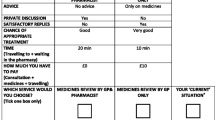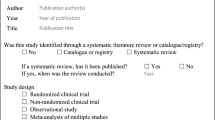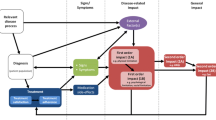Abstract
Background
The generic health-related quality-of-life (HR-QOL) utility measures the EQ-5D and SF-6D are both commonly used to inform healthcare policy developments. However, their application to pharmacy practice is limited and the optimal method to inform policy developments is unknown.
Objectives
Our objective was to test the sensitivity of the EQ-5D and SF-6D within pharmacy when measuring whether changes in health status or other co-variates at baseline affect the effectiveness of the intervention at follow-up. A further objective was to consider the implications of the findings for pharmacy research and policy.
Methods
The EQ-5D and SF-6D utility measures were employed within a randomized controlled trial (RCT) of community pharmacy-led medicines management for patients with coronary heart disease. The intervention covered a baseline visit with the potential for follow-up. Simultaneous quantile regression assessed the impact of the intervention on both EQ-5D and SF-6D measures at follow-up, controlling for baseline health, appropriateness of treatment, personal characteristics and self-reported satisfaction.
Results
No statistically significant difference in HR-QOL across the intervention and control groups at follow-up was reported for either measure. Increased health gain was however associated with the baseline utility score (with the EQ-5D more sensitive for those in worse health) and the appropriateness of treatment, but not patient characteristics or self-reported satisfaction.
Conclusion
Neither generic measure detected a gain in HR-QOL as a result of the introduction of an innovative pharmacy-based service. This finding supports other work in the area of pharmacy, where health gains have not changed following interventions. Disease-specific utility measures should be investigated as an alternative to generic approaches such as the EQ-5D and SF-6D. Given that the RCT found an increase in self-reported satisfaction, broader measures of benefit that value patient experiences, such as contingent valuation and discrete-choice experiments, should also be considered in pharmacy.
Similar content being viewed by others
References
Drummond MF, Sculpher MJ, Torrance GW, et al. Methods for the economic evaluation of health care programmes. Oxford: Oxford University Press; 2005.
Kaplan RM, Bush JW, Berry CC. Health status: types of validity and the index of well-being. Health Serv Res. 1976;11:478–507.
Torrance GW, Furlong W, Feeny D, Boyle M. Multi-attribute preference functions: Health Utilities Index. Pharmacoeconomics. 1995;7(6):503–20.
Sintonen H. The 15-D instrument of health-related quality of life: properties and application. Ann Med. 2001;33:328–36.
The Euroqol Group. Euroqol—a new facility for the measurement of health-related quality of life. Health Policy. 1990;16:199–208.
Brazier J, Roberts J, Deverill M. The estimation of a preference-based measure of health from the SF-36. J Health Econ. 2002;21:271–92.
Dolan P. Modelling valuations for Euroqol health states. Med Care. 1997;35:1095–108.
National Institute for Health and Clinical Excellence. http://www.nice.org.uk/. Accessed 13 Nov 2012.
Scottish Medicine Consortium. http://www.scottishmedicines.org.uk/. Accessed 13 Nov 2012.
Canadian Agency for Drugs and Technologies in Health. http://www.cadth.ca/index.php/en/home. Accessed 13 Nov 2012.
Department of Health and Ageing. Pharmaceutical Benefits Advisory Committee. Canberra: Australian Government; 2007. http://www.health.gov.au/internet/main/publishing.nsf/Content/health-pbs-general-listing-committee3.htm. Accessed 15 Jul 2011.
Department of Health and Ageing. Medical Services Advisory Committee. Canberra: Australian Government; 2011. http://www.msac.gov.au/. Accessed 13 Nov 2012.
Richardson G, Manca A. Calculation of quality adjusted life years in the published literature: a review of methodology and transparency. Health Econ. 2004;13:1203–10.
Boonen A, van der Heijde D, Landewé R, et al. How do the EQ-5D, SF-6D and the well-being rating scale compare in patients with ankylosing spondylitis? Ann Rheum Dis. 2007;66:771–7.
Conner-Spady B, Suarez-Almazor ME. Variation in the estimation of quality-adjusted life-years by different preference-based instruments. Med Care. 2003;41:791–801.
Fisk JD, Brown MG, Sketris IS, et al. A comparison of health utility measures for the evaluation of multiple sclerosis treatments. J Neurol Neurosurg Psychiatry. 2005;76:58–63.
Barton GR, Bankart J, Davis AC, Summerfield QA. Comparing utility scores before and after hearing-aid provision: results according to the EQ-5D, HUI3 and SF-6D. Appl Health Econ Health Policy. 2004;3(2):103–5.
Gerard K, Nicholson T, Mullee M, Mehta R, Roderick P. EQ-5D versus SF-6D in an older, chronically ill patient group. Appl Health Econ Health Policy. 2004;3(2):91–102.
Grieve R, Grishchenko M, Cairns J. SF-6D versus EQ-5D: reasons for differences in utility scores and impact on reported cost-utility. Eur J Health Econ. 2009;10:15–23.
Tidermark J, Bergstrom G, Svensson O, et al. Responsiveness of the EuroQol (EQ 5-D) and the SF-36 in elderly patients with displaced femoral neck fracture. Qual Life Res. 2003;12:1069–79.
Lamers LM, Bouwmans CAM, van Straten A, et al. Comparsion of EQ-5D and SF-6D utilities in mental health patients. Health Econ. 2006;15:1229–36.
Longworth L, Bryan S. An empirical comparison of EQ-5D and SF-6D in liver transplant patients. Health Econ. 2003;12:1061–7.
van den Hout WB, de Jong Z, Munneke M, et al. Cost-utility and cost-effectiveness analyses of a long-term, high-intensity exercise program compared with conventional physical therapy in patients with rheumatoid arthritis. Arthritis Rheum. 2005;53:39–47.
Marra CA, Marion SA, Guh DP, et al. Not all “quality-adjusted life years” are equal. J Clin Epidemiol. 2007;60:616–24.
Xie F, Li SC, Luo N, et al. Comparison of the EuroQol and short form 6D in Singapore multiethnic Asian knee osteoarthritis patients scheduled for total knee replacement. Arthritis Rheum. 2007;57:1043–9.
Michaels JA, Brazier JE, Campbell WB, et al. Randomized clinical trial comparing surgery with conservative treatment for uncomplicated varicose veins. Br J Surg. 2006;93:175–81.
Pickard AS, Johnson JA, Feeny DH. Responsiveness of generic health-related quality of life measures in stroke. Qual Life Res. 2005;14:207–19.
Stavem K, Froland SS, Hellum KB. Comparison of preference-based utilities of the 15D, EQ-5D and SF-6D in patients with HIV/AIDS. Qual Life Res. 2005;14:971–80.
Szende A, Svensson K, Ståhl E, Mészáros A, Berta GY. Psychometric and utility-based measures of health status of asthmatic patients with different disease control level. Pharmacoeconomics. 2004;22(8):537–47.
van Stel HF, Buskens E. Comparison of the SF-6D and the EQ-5D in patients with coronary heart disease. Health Qual Life Outcomes. 2006;4:20–9.
Seymour J, McNamee P, Scott A, et al. Shedding new light onto the ceiling and floor? A quantile regression approach to compare EQ-5D and SF-6D responses. Health Econ. 2010;19:683–96.
McDonough CM, Grove MR, Tosteson TD, et al. Comparison of EQ-5D, HUI, and SF-36-derived societal health state values among spine patient outcomes research trial (SPORT) participants. Qual Life Res. 2005;14:1321–32.
Brazier J, Roberts J, Tsuchiya A, et al. A comparison of the EQ-5D and SF-6D across seven patient groups. Health Econ. 2004;13:873–84.
Barton G, Sach T, Doherty M, et al. An assessment of the discriminative ability of the EQ-5D (index), SF-6D, and EQ VAS, using sociodemographic factors and clinical conditions. Eur J Health Econ. 2008;9:237–49.
Bharmal M, Thomas J. Comparing the EQ-5D and the SF-6D descriptive systems to assess their ceiling effects in the US general population. Value Health. 2006;9:262–71.
Petrou S, Hockley C. An investigation into the empirical validity of the EQ-5D and SF-6D based on hypothetical preferences in a general population. Health Econ. 2005;14:1169–89.
Wee HL, Machin D, Loke WC, et al. Assessing differences in utility scores: a comparison of four widely used preference-based instruments. Value Health. 2007;10:256–65.
Bryan S, Longworth L. Measuring health related utility: why the disparity between EQ-5D and SF-6D? Eur J Health Econ. 2005;50:253–60.
Espallargues M, Czoski-Murray CJ, Bansback NJ, et al. The impact of age-related macular degeneration on health status utility values. Invest Ophthalmol Vis Sci. 2005;46:4016–23.
Barton GR, Sach TH, Avery AJ, et al. Comparing the performance of the EQ-5D and SF-6D when measuring the benefits of alleviating knee pain. Cost Eff Resour Alloc. 2009;7:12.
Kontodimopoulos N, Pappa E, Papadopoulos AA, et al. Comparing SF-6D and EQ-5D utilities across groups differing in health status. Qual Life Res. 2009;18:87–97.
Moock J, Kohlmann T. Comparing preference-based quality-of-life measures: results from rehabilitation patients with musculoskeletal, cardiovascular, or psychosomatic disorders. Qual Life Res. 2008;17:485–95.
Kontodimopoulos N, Pappa E, Chadjiapostolou Z, et al. Comparing the sensitivity of EQ-5D, SF-6D and 15D utilities to the specific effect of diabetic complications. Eur J Health Econ. 2012;13(1):111–20.
McDonough CM, Tosteson AN. Measuring preferences for cost-utility analysis: how choice of method may influence decision-making. Pharmacoeconomics. 2007;25(2):93–106.
Simoens S. Economic evaluation of pharmacy practice: research informing policy. Int J Pharm Pract. 2008;16:337–8.
The Community Pharmacy Medicines Management Project Evaluation Team. The MEDMAN study: a randomised controlled trial of community pharmacy-led medicines management for patients with coronary heart disease. Fam Pract. 2007;24:189–200.
Holland R, Lenaghan E, Harvey I, et al. Does home based medication review keep older people out of hospital? The HOMER randomised controlled trial. BMJ. 2005;330:293.
Holland R, Brooksby I, Lenaghan E, et al. Effectiveness of visits from community pharmacists for patients with heart failure: HeartMed randomised controlled trial. BMJ. 2007;334:1098.
Lenaghan E, Holland R, Brooks A. Home-based medication review in a high risk elderly population in primary care: the POLYMED randomised controlled trial. Age Ageing. 2007;36:292–7.
RESPECT Trial Team. Cost-effectiveness of shared pharmaceutical care for older patients: RESPECT trial findings. Br J Gen Pract. 2010;60:20–7.
RESPECT Trial Team. Effectiveness of shared pharmaceutical care for older patients: RESPECT trial findings. Br J Gen Pract. 2010;60:10–9.
Scott T, Tinelli M, Bond C, Community Pharmacy Medicines Management Evaluation Team. Costs of a community pharmacist-led medicines management service for patients with coronary heart disease in England: healthcare system and patient perspectives. Pharmacoeconomics. 2007;25(5):397–411.
Pacini M, Smith R, Wilson E, Holland R. Home-based medication review in older people: is it cost effective? Pharmacoeconomics. 2007;25(2):171–80.
Etemad LR, Hay JW. Cost-effectiveness analysis of pharmaceutical care in a Medicare Drug Benefit Program. Value Health. 2003;6:425–35.
Newton HJ, editor. Stata technical bulletin: STB-38. College Station: Stata Corporation; 1997. http://stata-press.com/journals/stbcontents/stb38.pdf. Accessed 13 Nov 2012.
Greene WH. Econometric analysis. 6th ed. Upper Saddle River: Prentice Hall; 2008.
Tinelli M, Watson M, Hannaford P, et al. Development and application of a tool for the assessment of appropriateness of treatment for patients with CHD [abstract]. Int J Pharm Pract. 2005;13(suppl):R41.
Tinelli M, Blenkinsopp A, Bond C, on the behalf of the Community Pharmacy Medicines Management Evaluation Team. Development, validation and application of a patient satisfaction scale for a community pharmacy medicines management service. Int J Pharm Pract. 2011;19:144–55.
Xie J, Wu EQ, Zheng ZJ, et al. Patient-reported health status in coronary heart disease in the United States: age, sex, racial, and ethnic differences. Circulation. 2008;118:491–7.
Wenger NK, Mattson ME, Furberg CD, et al. Assessment of quality of life in clinical trials of cardiovascular therapies. Am J Cardiol. 1984;54:908–13.
Asadi-Lari M, Packham C, Gray D. Patients’ satisfaction and quality of life in coronary artery disease. Health Qual Life Outcomes. 2003;1:57–64.
Herrera LJ, Rubio G, Pomares H, Paechter B, Guillén A, Rojas I. Strengthening the forward variable selection stopping criterion. In: Allippi C, editor. Artificial neural networks—ICANN 2009: part II. Heidelberg: Springer; 2009. p. 215–24.
Dowie J. Decision validity should determine whether a generic or condition-specific HRQOL measure is used in health care decisions. Health Econ. 2002;11:1–8.
Cepeda-Valery B, Cheong AP, Lee A, Yan BP. Measuring health related quality of life in coronary heart disease: the importance of feeling well. Int J Cardiol. 2011;149:4–9.
Wijeysundera HC, Tomlinson G, Norris CM, et al. Predicting EQ-5D utility scores from the Seattle Angina Questionnaire in coronary artery disease. Med Decis Making. 2011;31:481–93.
van Mil F. Is Hawthorne bothering pharmaceutical care research? Pharm World Sci. 2003;25:37.
Hundley V, Ryan M. Willingness to pay and discrete choice experiments: alternatives to satisfaction surveys. Evid Based Midwifery. 2003;1:32–5.
Olsen JA, Smith RD. Theory versus practice: a review of ‘willingness to pay’ in health and health care. Health Econ. 2001;10:39–52.
de Bekker-Grob EW, Ryan M, Gerard K. Discrete choice experiments in health economics: a review of the literature. Health Econ. 2012;21(2):145–72.
Ryan M, Gerard K, Amaya-Amaya M, editors. Using discrete choice experiments to value health and health care. Dordrecht: Springer; 2008.
Blumenschein K, Johannesson M, Yokoyama K, et al. Hypothetical versus real willingness to pay in the health care sector: results from a field experiment. J Health Econ. 2001;20:441–57.
Naik-Panvelkar P, Armour C, Rose JM, Saini B. Patient preferences for community pharmacy asthma services: a discrete choice experiment. Pharmacoeconomics. 2012;30(10):961–76.
Ryan M, Ubach C. Testing for an experience endowment effect in health care. Appl Econ Lett. 2003;10:407–10.
Porteous T, Ryan M, Bond C, et al. Preferences for self-care or consulting a health professional for minor illness: a discrete choice experiment. Br J Gen Pract. 2006;56:911–7.
Tinelli M, Ryan M, Bond C. Patients’ preferences for an increased pharmacist role in the management of drug therapy. Int J Pharm Pract. 2009;17:275–82.
Acknowledgements
The authors would like to thank the medical statistician and senior lecturer Dr Lorna Aucott, University of Aberdeen, for her helpful comments and suggestions. The MEDMAN trial was funded by the Department of Health for England and Wales and managed by a collaboration of the National Pharmaceutical Association, the Royal Pharmaceutical Society of Great Britain, the Company Chemist Association and the Co-operative Pharmacy Technical Panel, led by the Pharmaceutical Services Negotiating Committee. The research in this paper was undertaken while the author M. Tinelli was undertaking a research fellowship jointly funded by the Economic and Social Research Council (ESRC) and the Medical Research Council (MRC). The Health Economics Research Unit (HERU), University of Aberdeen is funded by the Chief Scientist Office of the Scottish Government Health Directorate. The authors’ work was independent of the funders.
Conflicts of interest
The authors declare no conflicts of interest.
Author contributions
M. Tinelli contributed to data collection, analysis, and drafting and revision of this paper. M. Ryan contributed to planning of the analysis, interpretation of the results, and contributed to drafting and revision of this paper. C. Bond was the principal investigator and guarantor for the MEDMAN trial report. She contributed to the conception and design of the study, to the establishment of the team, to all aspects of study management, to planning of the analysis, interpretation of the results, and drafting and revision of this paper. A. Scott contributed to study design, some aspects of study management, some aspects of data analysis, and interpretation of the results. He also contributed to drafting and revision of this paper. C. Bond is the guarantor for the overall content of this paper.
Author information
Authors and Affiliations
Corresponding author
Electronic supplementary material
Below is the link to the electronic supplementary material.
Rights and permissions
About this article
Cite this article
Tinelli, M., Ryan, M., Bond, C. et al. Valuing Benefits to Inform a Clinical Trial in Pharmacy. PharmacoEconomics 31, 163–171 (2013). https://doi.org/10.1007/s40273-012-0012-7
Published:
Issue Date:
DOI: https://doi.org/10.1007/s40273-012-0012-7




